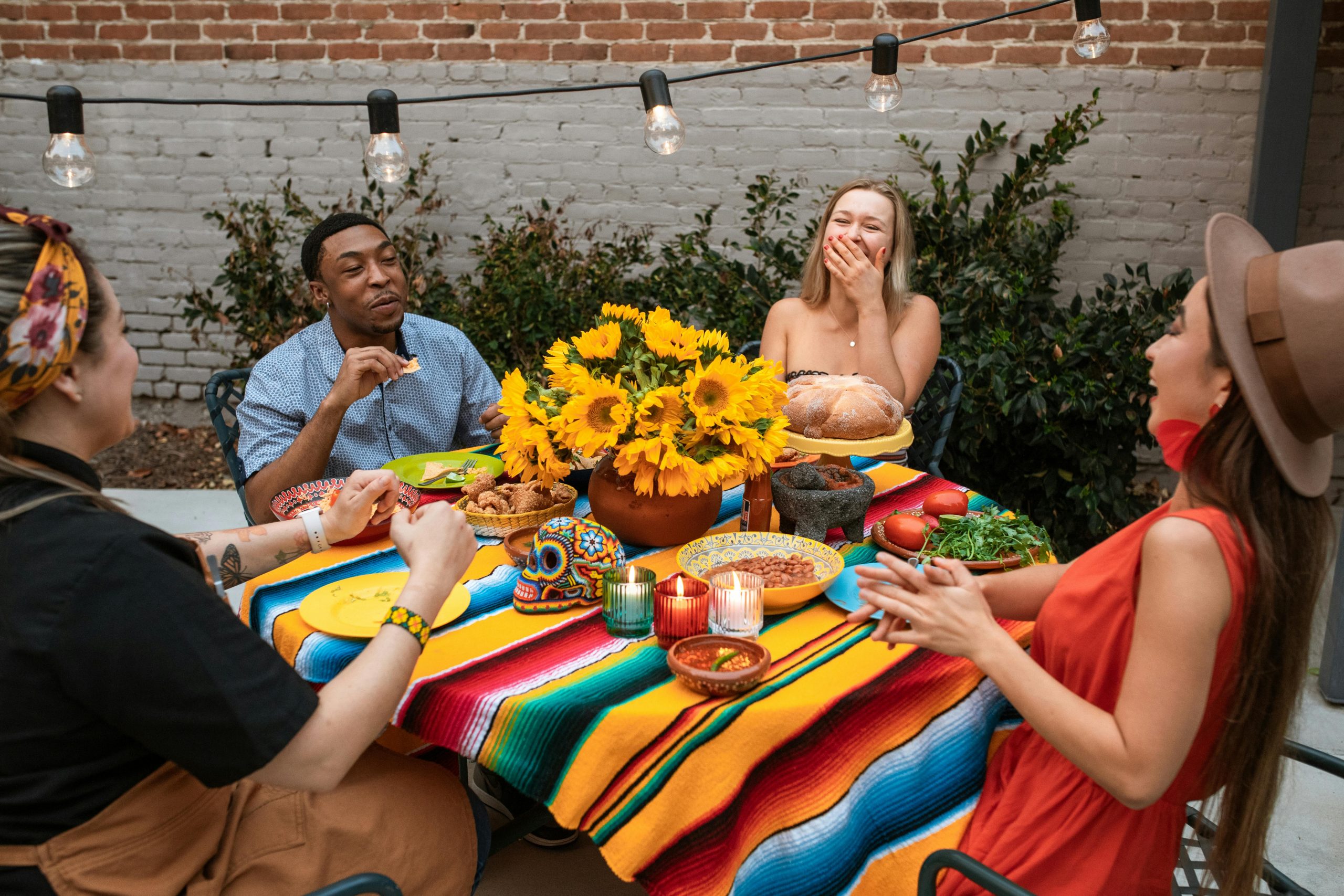Highlights
- Start planning early and set clear expectations for the event’s purpose, size, and budget.
- Choose a venue that’s convenient, comfortable, and suited to your group’s needs.
- Simplify the menu to avoid last-minute chaos, and accommodate different diets.
- Delegate responsibilities and involve family and friends in the planning process.
- Keep communication open and organized with guests and helpers.
- Focus on creating a welcoming atmosphere, not a perfect setup.
- Stay flexible and remember that connection matters more than perfection.

Planning a group celebration can be one of the most rewarding—and overwhelming—experiences for families. Whether it’s a milestone birthday, an anniversary dinner, a graduation party, or a casual family reunion, the process can easily shift from excitement to exhaustion if you don’t have a plan. Between coordinating guests, picking a location, managing food, and keeping everyone happy, it’s no surprise that many hosts feel stressed before the party even begins.
But here’s the good news: with a few smart strategies and the right mindset, planning a group celebration doesn’t have to drain your energy or your budget. In fact, it can be fun and fulfilling when you approach it with organization, teamwork, and realistic expectations. This guide walks you through step-by-step strategies to simplify the process—so you can enjoy the celebration as much as your guests do.
Start with a Clear Plan
Every successful event begins with clarity. Before you dive into invitations or decorations, take a moment to define your vision.
- Identify the Purpose and Theme
Ask yourself what kind of celebration you’re hosting. Is it a milestone birthday, a retirement party, or a casual get-together? The purpose of the event sets the tone for everything else—from the guest list to the décor.
A few guiding questions:
- What’s the main reason for this gathering?
- Is it formal, semi-formal, or casual?
- How many people do I want to invite?
- What’s my total budget?
Once you’ve identified the event type, choose a simple theme or color scheme. It doesn’t need to be elaborate—sometimes just choosing coordinated colors or a seasonal idea (like “summer picnic” or “autumn harvest”) can tie everything together beautifully.
- Set a Realistic Budget
Budgeting helps you prioritize what truly matters. Break down costs into key categories such as:
- Venue or location fees
- Food and beverages
- Decorations and supplies
- Entertainment or activities
- Invitations and thank-you cards
Always include a small “miscellaneous” buffer for unexpected costs. Knowing your limits early helps prevent stress later.
- Create a Planning Timeline
Start as early as possible—ideally 6 to 8 weeks ahead for small events, and 3 to 6 months for larger ones.
Make a checklist with deadlines for each task. Digital tools like Trello, Google Sheets, or Notion can make it easier to share updates and track progress.
Choose the Right Venue
The right venue can make or break your event. Think about your guest list, the time of year, and the kind of experience you want to create.
- Hosting at Home
Hosting at home is cost-effective and comfortable. It gives you control over timing, food, and décor. However, it also means handling setup, cleanup, and limited space.
To reduce stress when hosting at home:
- Keep décor minimal—simple centerpieces or string lights go a long way.
- Rearrange furniture to create open flow for guests.
- Borrow chairs, tables, or coolers from family and friends.
- Outdoor Venues
For family reunions or large groups, parks, gardens, and beachside areas can be great options. They offer space, fresh air, and often require minimal decoration. Remember to check for permits, reserve early, and prepare backup plans in case of bad weather.
- Restaurants and Event Spaces
If you’d rather skip the setup and cleanup, booking a restaurant or banquet hall can be a smart choice. Look for a restaurant that is ideal for group dinners—one that offers a family-friendly environment, flexible menu options, and enough seating for everyone to relax comfortably.
When choosing an external venue:
- Confirm parking and accessibility for all ages.
- Ask about private rooms or reserved areas.
- Check for any restrictions on décor, noise, or bringing your own cake.
Simplify the Menu
Food is often the heart of any gathering—and one of the biggest sources of stress. Keeping it simple doesn’t mean sacrificing quality; it means creating a menu that’s satisfying, easy to manage, and inclusive.
- Potluck-Style Meals
Encourage guests to bring their favorite dish. It’s a wonderful way to share family recipes and lighten the host’s workload. You can assign categories (main course, side, dessert, beverages) to avoid duplicates.
- Catering or Pre-Ordering
If you prefer less kitchen time, order from local restaurants or caterers. Many offer affordable group packages or family platters. Choose a mix of options that suit different diets—vegetarian, gluten-free, and kid-friendly items.
- Make-Ahead Dishes
Prepare parts of the meal in advance so you’re not scrambling on the day of the event.
Great make-ahead options include:
- Pasta or grain salads
- Slow cooker dishes like pulled pork or chili
- Finger foods such as mini sandwiches or wraps
- Desserts like brownies or fruit platters
- Set Up a Buffet or Food Station
Self-serve setups let guests help themselves and keep the flow natural. They also free you from serving duties, giving you time to mingle.
Delegate & Involve Others

One of the biggest mistakes in event planning is trying to do everything yourself. The secret to stress-free group celebrations is teamwork.
- Assign Roles Early
Ask for help and assign specific responsibilities. You’ll be surprised how willing people are to pitch in when they know what’s expected.
Examples of roles include:
- Decor coordinator: handles decorations and table settings.
- Food organizer: manages the menu or potluck list.
- Music manager: sets up playlists or speakers.
- Games & entertainment lead: coordinates activities for kids and adults.
- Cleanup crew: helps restore order after the event.
- Get the Kids Involved
Children love feeling included. Let them design invitations, fold napkins, or decorate name cards. These small tasks make them proud and engaged in the celebration.
- Don’t Hesitate to Accept Help
If a friend offers to bring an extra dish or come early to help set up—say yes. Accepting help is not a sign of weakness; it’s a sign of smart planning.
Keep Communication Clear
Good communication keeps confusion and frustration at bay. Whether you’re coordinating with family members or vendors, clear updates make everything smoother.
- Centralize Information
Create a shared group chat, Facebook event page, or email thread where guests can ask questions and confirm details. This prevents messages from getting lost.
- Be Specific in Invitations
Include all the essential details:
- Date, time, and location
- Parking or entrance instructions
- Dress code (if any)
- What guests should bring (food, gifts, chairs, etc.)
- RSVP deadline
- Handle Changes Gracefully
Things happen—guests cancel, food runs late, or weather shifts plans. Keep your tone positive and adaptable when sharing updates. People respond better to calm and clarity than last-minute panic.
Create a Comfortable Atmosphere
Once the logistics are set, it’s time to think about ambiance. The goal is to make guests feel relaxed, welcome, and connected.
- Focus on Simple Décor
You don’t need a Pinterest-perfect setup to create charm. Use what you already have and highlight one or two focal points, like a pretty centerpiece or themed tablecloth.
Low-stress décor ideas:
- String lights or candles for warm evening glow.
- Fresh flowers or greenery from your garden.
- DIY banners or printed photos of past family moments.
- Plan Easy Entertainment
The best activities encourage laughter and connection. Depending on your group’s age mix, you can include:
- Family trivia or charades
- Board games and card tables
- Outdoor games like cornhole or badminton
- A photo booth corner with props
- Music playlists featuring everyone’s favorites
- Make Everyone Feel Included
Be mindful of guests who may not know each other well. Introduce people, start conversations, and create spaces where small groups can chat comfortably.
Expect the Unexpected
Even with careful planning, surprises are inevitable. A sudden rain shower, a late delivery, or a forgotten dish can throw things off—but it doesn’t have to ruin the day.
- Prepare Backup Plans
Keep a few backup options handy:
- Have extra chairs, paper plates, and napkins on standby.
- Store easy snacks or frozen appetizers in case food runs low.
- For outdoor events, set up a covered area or indoor alternative.
- Stay Flexible
If something goes wrong, smile and move forward. Most guests won’t notice small mistakes—they’re there to enjoy your company, not inspect your décor or timing.
- Embrace Imperfection
Sometimes the funniest or most memorable stories come from unexpected mishaps. A spilled drink or last-minute change can turn into a great laugh later.
Enjoy the Celebration You Planned
After weeks or months of preparation, it’s easy to stay in “host mode” the whole time—but don’t forget why you planned this celebration in the first place. Take time to enjoy the moment.
- Be Present
Once the event starts, step away from the to-do list. Sit down, talk to your guests, and let yourself relax.
- Capture Memories
Ask someone to take photos or set up a shared album link for guests to upload their pictures. You’ll appreciate these snapshots long after the event ends.
- Express Gratitude
Afterward, send a quick thank-you message or card to guests who contributed time or food. It doesn’t have to be formal—just sincere.
Conclusion
Planning a group celebration doesn’t need to be an exhausting juggling act. With a clear plan, shared responsibilities, and realistic expectations, you can create an event that feels joyful instead of overwhelming. Remember: your guests won’t remember whether the napkins matched the tablecloths—but they’ll always remember how they felt at your gathering.
Keep your focus on connection, laughter, and shared memories. That’s what truly makes a celebration special. By planning thoughtfully and letting go of perfection, you’ll not only host a stress-free event—you’ll also enjoy it right alongside everyone else.
